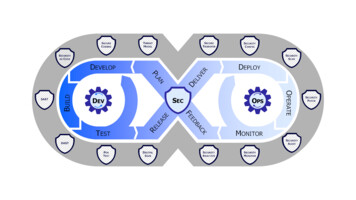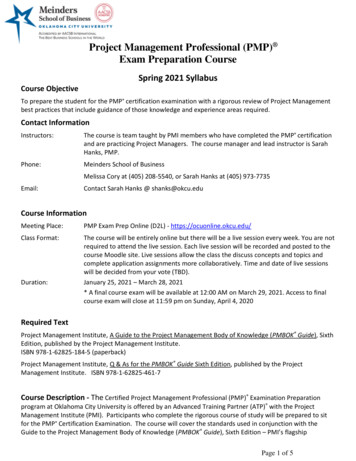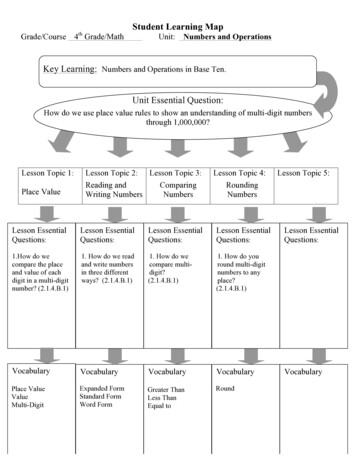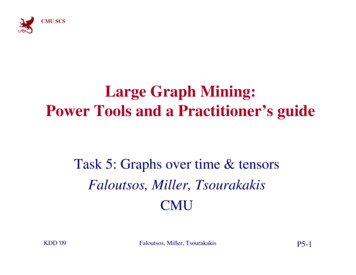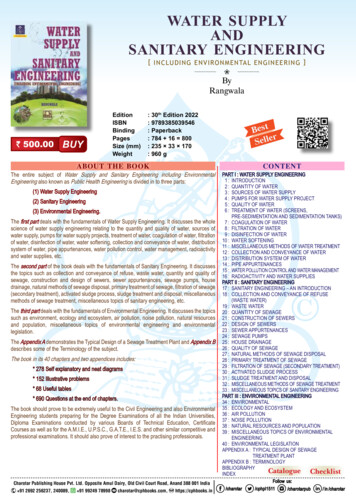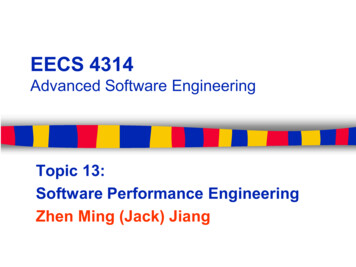
Transcription
EECS 4314Advanced Software EngineeringTopic 13:Software Performance EngineeringZhen Ming (Jack) Jiang
Acknowledgement Adam PorterAhmed HassanDaniel MenaceDavid LiljaDerek FooDharmesh ThakkarJames HoltmanMark SyerMurry WoodsidePeter ChenRaj JainTomáš KaliberaVahid Garousi
Software Performance Matters
What is Software Performance?“A performance quality requirement defines a metric thatstates the amount of work an application must perform ina given time, and/or deadlines that must be met forcorrect operation”.- Ian Gordon, Essential Software Architecture
Performance Metrics (1) Response time– a measure of how responsive an application orsubsystem is to a client request. Throughput– the number of units of work that can be handledper unit of time (e.g., requests/second, calls/day,hits/hour, etc.) Resource utilization– the cost of the project in terms of system resources.The primary resources are CPU, memory, disk I/Oand network.
Performance Metrics (2) Availability– the probability that a system is in a functionalcondition Reliability– the probability that a system is in an error-freecondition Scalability– an application’s ability to handle additional workload,without adversely affecting performance, by addingresources like CPU, memory and disk
Common Goals ofPerformance Evaluation (1)EvaluatingDesign Alternatives Should my applicationservice implement the pushor pull mechanism tocommunicatewithmyclients?Comparing SystemImplementations Does my application serviceyield better performance thanmy competitors?Benchmarking
Common Goals ofPerformance Evaluation (2)Performance Debugging Which part of the systemslows down the overallexecutions?Performance Tuning What are the configurationvalues that I should set toyield optimal performance?
Common Goals ofPerformance Evaluation (3)Performance Prediction How would the system looklike if the number of usersincrease by 20%?what-if analysisCapacity Planning What kind of hardware(types and number ofmachines) or componentsetup would give me thebest bang for my buck?
Common Goals ofPerformance Evaluation (4)Performance Requirements How can I determine theappropriate Service LevelAgreement (SLA) policiesfor my service?Operational Profiling What is the expected usageonce the system is deployedin the field?workload characterization
Performance Evaluation v.s.Software Performance Engineering “Contrary to common belief, performanceevaluation is an art. Like a work of art,successful evaluation cannot be producedmechanically.”- Raj Jain, 1991 “[Software Performance Engineering]Utterly demystifies the job (no longer theart) of performance engineering”- Connie U. Smith and Lloyd G. Williams, 2001
When should we start assessingthe system performance?“It is common sense that we need to develop theapplication first before tuning the performance.”- Senior Developer AMany performance optimizations are related to thesystem architecture. Parts or even the whole systemmight be re-implemented due to bad performance!
We should start performanceanalysis as soon as possible!Originated by Smith et al.To validate the system performanceas early as possible (even at therequirements or design phase)“Performance By Design”
Software Performance EngineeringDefinition: Software Performance Engineering (SPE)represents the entire collection of software engineeringactivities and related analyses used throughout thesoftware development cycle, which are directed tomeeting performance requirements.- Woodside et al., FOSE 2007
SPE ActivitiesPerformanceRequirementsPerformanceTest DesignScenariosOperationalProfileAnalyze Early-cyclePerformance ModelsProduct Architecture and Design(measurements and mid/late models: evaluate, diagnose)PerformanceTestingPerformanceAnti-pattern DetectionProduct evolve/maintain/migrate(Late-cycle Performance Models:evaluate temAnalysis[Woodside et al., FOSE 2007]
Three General Approaches ofSoftware Performance EngineeringMeasurementUsually applies late inthe development cyclewhen the system isimplementedAnalytical ModelingSimulationUsually applies early in thedevelopmentcycletoevaluate the design orarchitecture of the systemCan be used both duringthe early and the latedevelopment cycles
Three General Approaches ofSoftware Performance EngineeringMeasurementAnalytical ighMedium
Three General Approaches ofSoftware Performance EngineeringMeasurementUsually applies late inthe development cyclewhen the system isimplementedAnalytical ModelingUsually applies early in thedevelopmentcycletoevaluate the design orarchitecture of the systemSimulationCan be used both duringthe early and the latedevelopment cyclesConvergence of the approaches
Books, Journals and Conferences
Roadmap Measurement––––Workload CharacterizationPerformance MonitoringExperimental DesignPerformance Analysis and Visualization Simulation Analytical Modeling––––Single QueueQueuing Networks (QN)Layered Queuing Networks (LQN)PCM and Other Models Performance Anti-patterns
Performance Evaluation- Measurement
Measurement-basedPerformance EvaluationMinimum # of experiments,Maximum amount of esigntesting, benchmarking,capacity planning, -weight performancemonitoring and data recording
Operational Profiling(Workload Characterization)An operational profile, also called a workload,is the expected workload of the system undertest once it is operational in the field.The process of extracting the expectedworkload is called operational profiling orworkload characterization.
Workload Characterization Techniques Past data– Average/Minimum/Maximum request rates– Markov Chain– Extrapolation– Alpha/Beta usage data– Interview from domain experts– Workload characterization surveys– M. Calzarossa and G. Serazzi. Workload characterization: asurvey. In Proceedings of the IEEE.1993.– S. Elnaffar and P. Martin. Characterizing Computer Systems'Workloads. Technical Report. School of Computing, Queen'sUniversity. 2002.
Workload Characterization Techniques- Markov Chainweb access logs for the past few months
Workload Characterization Techniques- Markov Chain192.168.0.1 - [22/Apr/2014:00:32:25 -0400] "GET/dsbrowse.jsp?browsetype title&browse category &browse actor &browse title HOLY%20AUTUMN&limit num 8&customerid 41HTTP/1.1" 200 4073 10192.168.0.1 - [22/Apr/2014:00:32:25 -0400] "GET/dspurchase.jsp?confirmpurchase yes&customerid 5961&item 646&quan 3&item 2551&quan 1&item 45&quan 3&item 9700&quan 2&item 1566&quan 3&item 4509&quan 3&item 5940&quan 2 HTTP/1.1"200 3049 177192.168.0.1 - [22/Apr/2014:00:32:25 -0400] "GET/dspurchase.jsp?confirmpurchase yes&customerid 41&item 4544&quan 1&item 6970&quan 3&item 5237&quan 2&item 650&quan 1&item 2449&quan 1 HTTP/1.1" 200 2515 113Web Access Logs
Workload Characterization Techniques- Markov Chain192.168.0.1 - [22/Apr/2014:00:32:25 -0400] "GET/dsbrowse.jsp?browsetype title&browse category &browse actor &browse title HOLY%20AUTUMN&limit num 8&customerid 41HTTP/1.1" 200 4073 10192.168.0.1 - [22/Apr/2014:00:32:25 -0400] "GET/dspurchase.jsp?confirmpurchase yes&customerid 5961&item 646&quan 3&item 2551&quan 1&item 45&quan 3&item 9700&quan 2&item 1566&quan 3&item 4509&quan 3&item 5940&quan 2 HTTP/1.1"200 3049 177192.168.0.1 - [22/Apr/2014:00:32:25 -0400] "GET/dspurchase.jsp?confirmpurchase yes&customerid 41&item 4544&quan 1&item 6970&quan 3&item 5237&quan 2&item 650&quan 1&item 2449&quan 1 HTTP/1.1" 200 2515 113For customer 41: browse - purchase
Workload Characterization Techniques- Markov 050.8
Experimental Design Suppose a system has 5 user configuration parameters.Three out of five parameters have 2 possible values and theother two parameters have 3 possible values. Hence, thereare 23 32 72 possible configurations to test. Apache webserver has 172 user configuration parameters(158 binary options). This system has 1.8 1055 possibleconfigurations to test!The goal of a proper experimental design isto obtain the maximum information withthe minimum number of experiments.
Experimental Design Terminologies The outcome of an experiment is called the responsevariable.–E.g., throughput and response time for the tasks. Each variable that affects the response variable and hasseveral alternatives is called a factor.–E.g., to measure the performance of a workstation, there arefive factors: CPU type, memory size, number of disk drivesand workload. The values that a factor can have are called levels.–E.g., Memory size has 3 levels: 2 GB, 6 GB and 12 GB Repetition of all or some experiments is called replication. Interaction effects: Two factors A and B are said tointeract if the effect of one depends on the other.
Ad-hoc ApproachIteratively going through each(discrete and continuous)factors and identity factorswhich impact performance foran three-tired e-commercesystem.[Sopitkamol et al., WOSP 2005]
Covering Array A t-way covering array for a given input space model is a set ofconfigurations in which each valid combination of factor-valuesfor every combination of t factors appears at least once. Suppose a system has 5 user configuration parameters. Three outof five parameters have 2 possible values (0, 1) and the othertwo parameters have 3 possible values (0, 1, 2). There are total23 32 72 possible configurations to test.A 2-way covering 10022
Covering Array and CIT There are many other kinds of covering arraylike: variable-strength covering array, test caseaware covering array, etc. Combinatorial Interaction Testing (CIT) modelsa system under test as a set of factors, each ofwhich takes its values from a particular domain.CIT generates a sample that meets the specificcoverage criteria (e.g., 3-way coverage). Many commercial and free tools:http://pairwise.org/tools.asp[Yilmaz et al., IEEE Computer 2014]
Performance Measurement Types of performance data Performance Monitoring– Agent-less Monitoring– Agent-based Monitoring Measurement-based frameworks Performance measurement issues
Performance Data System and application resource usage metrics– CPU, memory, network, etc. Application performance metrics– Response time, throughput, # of requests submittedand # of requests completed, etc. Application specific metrics– # of concurrent connections to the database, rate ofdatabase transactions, # of garbage collections Some of these data can be obtained directly, whileothers need to be derived (e.g., from logs).
Performance Monitor Monitors and records the system behaviorover time Needs to be light-weight– Imposing as little performance overhead aspossible Two types of performance monitoringapproaches– Agent-less monitoring– Agent-based monitoring
Agent-less Monitoring ExamplesTask ManagerJConsolePerfMon (Windows), sysstat (Linux), top
Agent-based Monitoring ExamplesApp DynamicsDell FogLight, New RelicCA Willy
A Framework for Measurementbased Performance dingPerformanceModelPerformanceDataControl FlowData FlowCapacity Planning[Thakkar et al., WOSP 2008]
Talos- Mozilla Performance Regression Testing hServerRegressionDetectionScriptRegressionNotice Email[Talbert et al., http://aosabook.org/en/posa/talos.html]
Skoll – A Distributed ContinuousQuality Assurance (DCQA) requesttaskclient kitClients WhenClientregisters&receivesclientit kitrequestsQA taskServer s& askthatmatchesclient acharacteristicsPerformance Regression Testingunder different configurations[Memon et al., ICSE 2004]
Measurement Bias Measurement bias is hard to avoid andunpredictable. Example 1: How come the same applicationtoday runs faster compared with yesterday? Example 2: Why the response time is verydifferent when running the same binary underdifferent user accounts? Example 3: Why the code optimization onlyworks on my computer? Repeated measurement Randomize experiment setup[Mytkowicz et al., ASPLOS 2010]
Performance Analysis Statistical analysis– Descriptive statistics– Hypothesis testing– Regression analysis Performance visualization Performance debugging– Profiling– Instrumentation
Comparing Two Alternatives Paired observations– E.g., there are six scenarios ran on two versions of the system.The response time are: {(5.4, 19.1), (16.6, 3.5), (0.6, 3.4), (1.4,2.5), (0.6, 3.6), (7.3, 1.7)}– Paired student-t test Unpaired observations– E.g., the browsing scenarios were ran 10 times on Release A and11 times on Release B– Unpaired student-t test Student-t tests assume that the two datasets are normallydistributed. Otherwise, we need to use non-parametric tests– Wilcoxon signed-rank test for paired observations– Mann-Whitney U test for the unpaired observations
Comparing More thanTwo Alternatives For comparing more than two alternatives, we willuse ANOVA (Analysis of variance)– E.g., There are 6 different measurements under 6different software configurations. ANOVA also assumes the datasets are normallydistributed. Otherwise, we need to use nonparametric tests (e.g., Kruskal-Wallis H test)
Statistical significance v.s.Performance impact The new design’s performance may bestatistically faster than the old version. However,it’s only 0.001 seconds faster and will take along time to implement. Is it worth the effort?Effect Sizes Trivial(Cohen’s D 0.2)Small(0.2 Cohen’s D 0.5)Medium if 0.5 Cohen’s D 0.8Large0.8 Cohen’s DCliff’s δ - Non-parametric alternative
Regression-based Analysis Can we find an empirical model which predictsthe application CPU utilization as a function of theworkload? For example,𝐶𝑃𝑈 𝑏0 𝑏1 # 𝑜𝑓 𝑏𝑟𝑜𝑤𝑠𝑖𝑛𝑔 𝑏2 # 𝑜𝑓 𝑠𝑒𝑎𝑟𝑐ℎ𝑖𝑛𝑔 Then we can conduct various what-if analysis?– (Field Assessment) What if the field workload is A,would the existing setup be able to handle that load?– (Capacity Planning) What kind of machine (CPUpower) should we pick based on the projectworkload for next 3 years?Are input variables linearly independent of each other?If they are highly correlated, keep only one of them in the model
Performance Visualization
Line PlotsMetrics plots from vmstats[Holtman, 2006]
Histogram Plots[Holtman, 2006]
Scatter Plot[Jiang et al., ICSM 2009]
Hexbin Plot[Holtman, 2006]
Box-PlotWidth of the box is proportional to the square rootof the number of samples for that transaction type[Holtman, 2006]
Violin Plot[Georges et al., OOPSLA 2007]
Bean Plot[Jiang et al., ICSM 2009]
Control Charts[Nguyen et al., APSEC 2011]
Gantt ChartShows the relative duration of anumber of (Boolean) conditions[Jain, 1991]
Instrumentation Source code level instrumentation– Ad-hoc manual instrumentation,– Automated instrumentation (e.g., AspectJ), and– Performance instrumentation framework (e.g., theApplication Response Time API) Binary instrumentation framework– DynInst (http://www.dyninst.org/),– PIN (http://www.dyninst.org/)– Valgrind (http://valgrind.org/) Java Bytecode instrumentation framework– Ernst’s ASE 05 tutorial on “Learning from executions:Dynamic analysis for software engineering and programunderstanding”(http://pag.csail.mit.edu/ mernst/pubs/dynamic-tutorialase2005-abstract.html)
Profiling Profilers can help developers locate “hot” methods– Methods which consume the most amount of resources(e.g., CPU)– Methods which take the longest– Methods which are called frequently Examples of profilers:––––Windows events: xperfJava applications: xprof, hprof, JProfiler, YourKit.net applications: YourKitDump analysis: DebugDiag (Windows dumps), EclipseMemory Analyzer (Java heap dumps)– Linux events: SystemTap/Dtrace, lttng
JProfiler
How JProfiler works Monitors the JVM activities via the JVM ToolInterface (JVMTI) to trap one or more of thefollowing event types:––––Lifecycle of classes,Lifecycle of threads,Lifecycle of objects,Garbage collection events, etc. System overhead v.s. the details of system behavior– The more the types of monitored events, the higher thetotal number of events collected by the profiler, theslower the system is (higher overhead)– To reduce overhead: the profiler is recommended to run under sampling mode, and select only the “needed” types of events to ler/help/doc/index.html
Evaluating the Accuracy of Java Profilers This paper shows that four commonly-used Javaprofilers (xprof, hprof, jprofile, and yourkit) oftendisagree on the identity of the hot methods. The results of profilers disagree because– They are run under the “sampling” mode– The samples are not randomly selected They are all “yield point-based” profilers The “observer effect” of profilers Using a differentprofiler can lead to differences in the compiled code(dynamic optimizations by the JVM) and subsequentlydifferently placed yield points[Mytkowicz et al., PLDI 2010]
Performance Evaluation- Simulation
Simulation A simulation model can be used– when during the design stage or even somecomponents are not available; or– when it is much cheaper and faster thanmeasurement-based approach (Simulating an 8hour experiment is much faster than running theexperiment for 8 hours.) However, the simulation models– usually take longer to develop than the analyticalmodels, and– are not as convincing to practitioners as themeasurement-based models
Evaluating the Performance Impactof Software Design ChangesDeveloped using the OMNetT framework[Foo et al., MESOCA 2011]
Simulation Used extensively in computer networking. It is alsogaining popularity in SPE, especially when it is used tosolve performance models. Popular simulation frameworks– NS2 network simulator: http://isi.edu/nsnam/ns/– OMNeT network simulation framework:http://www.omnetpp.org/– OPNet: ment-control/opnet.html
Performance Evaluation- Analytical Modeling
Performance Models Performance models describe how systemoperations use resources and how resourcecontent affects operations. Early-cycle performance models can predict asystem’s performance before it’s build, or assessthe effect of a change before it’s carried out.During the requirements or design stages Late-cycle performance models explore ives to support the evolution of these largesoftware systems.Uses data from the measurement-based approach
Basic Components of a Queue# of ServersQueue SizeArrival RateService TimeCustomers waitingin the queueCustomerpopulationCustomers currentlybeing serviced
Performance Anti-patterns
Performance Anti-Patterns A pattern is a common solution to a problem thatoccurs in many different contexts. Patterns captureexpert knowledge about “best practices” insoftware design in a form that allows thatknowledge to be reused and applied in the designof many different types of software. An anti-pattern documents common mistakes madeduring software development as well as theirsolutions. A performance anti-pattern can lie at the– software architecture or design level, or– code level[Smith et al., WOSP 2000]
Design-level Anti-patterns- Circuitous Treasure Hunt[Smith et al., WOSP 2000]
Design-level Anti-patterns- Circuitous Treasure Hunt Redesign the database schema Refactor the design to reduce the #of database calls[Smith et al., WOSP 2000]
Code-level Anti-patterns- Repetitive ComputationsQuestion: where is the redundant computation?A JFreeChart Performance bug[Nistor et al., ICSE 2013]
Detecting architecture/design levelanti-patterns Define software performance requirements for thesystem (response time, throughput and utilization) Encode the studied system architecture into thePCM with service demands and workload Encode the design/architecture level performanceanti-patterns using rules Analyze the performance of the PCM model to seeif it violates any performance requirements (If there are performance requirements violated,)Detect the performance anti-patterns using theencoded rules[Trubianiet et al., JSS 2014]
Mining Historical Data forPerformance Anti-patterns Randomly sampled 109 real-world performancebugs from five open source software systems(Apache, Chrome, GCC, Mozilla and MySQL) Static Analysis: Encode them as rule-checkersinside LLVMAn example of a Mozilla bug – Intensive GCs[Jin et al., PLDI 2012]
Performance Anti-patterns- Repetitive Loop Iterations Dynamic Analysis: Using the soot frameworkto detect similar memory access in the loopsA JFreeChart Performance bug[Nistor et al., ICSE 2013]
Accessing the DatabaseUsing ORMUser u findUserByID(1);select u from userwhere u.id 1;ORM update user setu.setName(“Peter”);Objectsname “Peter”where user.id 1;DatabaseSQLs[Chen et al., ICSE 2014]
Performance Anti-patternsin HibernateCompany company em.find(Company.class, companyID 1);for (Department d : company.getDepartment()) {List Employee e d.getEmployee();for (Employee tmp : e) {tmp.getId();}}select c from company c where c.ID 1select e from employee e where e.ID departmentID.1select e from employee e where e.ID departmentID.2 select e from employee e where e.ID departmentID.n[Chen et al., ICSE 2014]
Performance Anti-patternsin Hibernate@Fetch(FetchMode.SUBSELECT) private List Employee employeeCompany company em.find(Company.class, companyID 1);for (Department d : company.getDepartment()) {List Employee e d.getEmployee();for (Employee tmp : e) {tmp.getId();}}select c from company c where c.ID 1select * from employee e where e.departmentID (select departmentID where department.company.id 1)20 Department,10 Employee200 Department,10 Employee20000 Department,10 EmployeeBefore (ms)282 ms1238ms20462msAfter (ms)214ms ( 24%)715ms ( 42%)6382ms ( 69%)[Chen et al., ICSE 2014]
Two types of performance monitoring approaches -Agent-less monitoring -Agent-based monitoring . Agent-less Monitoring Examples Task Manager JConsole PerfMon (Windows), sysstat (Linux), top . Agent-based Monitoring Examples App Dynamics CA Willy Dell FogLight, New Relic . A Framework for Measurement- based Performance Modeling Test Enumerati on


